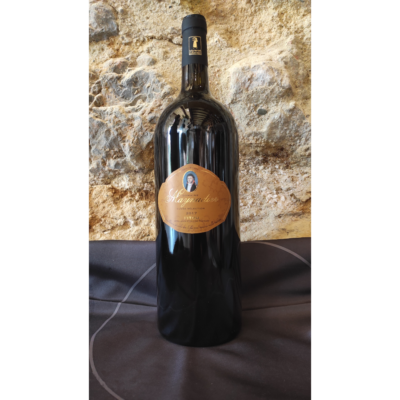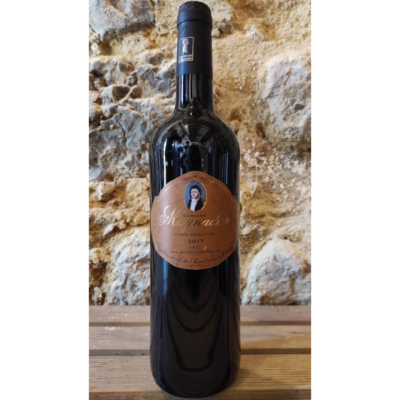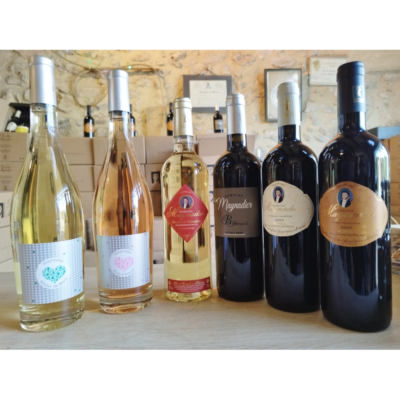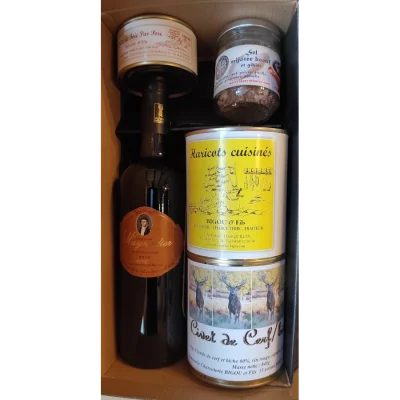The AOC Fitou dates back to 1948 but the region had already been developed by the Romans who exported its wine, long before the birth of Jesus Christ. Today, Fitou wine is known and recognised throughout France and far beyond our borders. Benefiting from the resources of the soil and the climate of the Corbières massif, the very high quality of this wine is the pride of the winegrowers who work hard to make it even better.
The AOC Fitou
The Romans were responsible for the development of the vines which today are part of the Fitou AOC. In 118 B.C., the Via Domitia linking Italy to the Iberian Peninsula allowed the trade and export of wine. The remains of amphorae from that period attest to this. The fall of the Roman Empire and the barbarian invasions put a definite brake on winegrowing, but it survived despite everything
The 18th century saw some very harsh climatic episodes with winters that killed the cereal and olive crops. The vine, on the other hand, adapted so well to these extreme conditions that in the 19th century it reigned alone on the Corbières massif and it is estimated that in 1850, Fitou was exclusively a wine-growing area.

- Le village de Fitou
After a destructive episode of mildew and phylloxera, production took off again and, at the end of the century, the departments of Aude, Gard, Hérault and Pyrénées Orientales represented 40% of the wine production in France. The first cooperative cellars were created and Fitou wine gained a reputation for excellence in the trade but, in the absence of labelling specifying the origin, remained unknown to the general public.
The creation of the AOC label – Appellation d’Origine Contrôlée
The southern winegrowers having suffered so much from the wine crisis at the beginning of the 20th century, their anger rumbled and they organised a revolt to obtain an organisation of the appellation of their wines to cut short the unscrupulous merchants who affixed deceptive labels. A first law was promulgated in 1919. It was only concerned with the notion of terroir, but it was the first step towards the creation of the AOC in 1935, on the initiative of a senator from Bordeaux – Jean Capus – encouraged by his friend Baron Pierre Le Roy de Boiseaumarié, a winegrower in Châteauneuf du Pape.
The AOC takes into account the area of production, the choice of grape varieties, the minimum alcoholic strength and the growing processes.
The creation of the AOC
That same year, the winegrowers of Caves, Fitou, Leucate, La Palme and Treilles created the Comité de Défense pour les vins rouges de Fitou. The Second World War interrupted the process, which was resumed as soon as peace returned, thanks to the rallying of the high cantons of Tuchan, Paziols, Villeneuve and Cascastel.
In 1947, the INAO – Institut National des Appellations d’Origine – in charge of issuing AOCs, was asked to establish the recognition of Fitou wine and this was done on 28 April 1948, when a decree made the AOC Fitou official.
To this day, although the natural yield is relatively low, the winemakers work hard to live up to their reputation, while preserving the windy Mediterranean landscape so characteristic of the Corbières massif.
The wines of the AOC Fitou
The wines of the AOC Fitou are an excellent reflection of the treasures of the beautiful region from which they come. They are complex, rich and above all very diverse to satisfy all tastes.
We find the aromas of the terroir with fruity notes: cherries, figs, citrus fruits, quetsches, red fruits, prunes, etc.; floral with violet for the most part; vegetal with mushrooms and the scents of the undergrowth; spicy: garrigue, laurel, white pepper, thyme, nutmeg, cinnamon, cloves, rosemary, bouquet garni, liquorice…; balsamic for the resin, oak and wood part; game animal and empyreumatic: cigar box, Havana, tapenade, dark chocolate, roasted coffee, rancio, smoked, grilled, cocoa, tobacco…
As far as gastronomy is concerned, Fitou wine goes wonderfully well with maritime products: eel from Leucate, oysters, fresh anchovies, sardinades, red mullet, sole, sea bream… But also with meats, not forgetting salads and raw vegetables.

- Les vins Maynadier
If we summarise Fitou wine in figures, we obtain the following results:
- 9 villages ;
- 2600 hectares of vineyards;
- 4 major grape varieties;
- 3 cooperative structures ;
- 270 cooperative members;
- 37 private cellars;
- 75,000 hl of production;
- 35 hl/ha average yield.
Grape varieties
Carignan is the traditional grape variety with a ruby red colour and a robust structure. It is found in all nine communes of the Languedoc.
Grenache Noir has long since found its place on this terroir. It brings unctuousness, velvetiness and finesse. Mourvèdre and Syrah are more recent. The Mourvèdre provides tannic structure and finesse, while the Syrah is distinguished by its beautiful aromatic persistence in the mouth.
Fitou wines are made from a blend of 40% Carignan, 40% Grenache and Mourvèdre and Syrah compete for the remaining 20%. The talent of the winemakers does the rest to elaborate original blends.
Wine-making
The Fitou harvest is divided between manual and mechanised harvesting, although there is a predilection for the former. The work on the old plots in particular respects traditional methods and 60% of the harvest is done by hand.
The vinification process follows two procedures which influence the character of the wine and mark the style of the Fitou AOC:
- The traditional vinification process with crushed bunches of grapes or with partial or total destemming;
- The whole grape maceration process.
Winemakers most often combine these two methods to make full-bodied, fruity wines that are appreciated for their suppleness.
The barrel ageing traditionally found in many great vintages is another of the characteristics of this wine.

- The vineyards of Fitou
Geographical area
The soils dedicated to the Fitou AOC extend over approximately 2600 hectares between the Mediterranean Sea and the Corbières massif in the Aude department. This terroir is made up of two distinct entities, some thirty kilometres apart:
To the east :
The territory groups together five communes of the Piedmont of the Corbières Maritimes, bordering the pond and the Mediterranean Sea. The hills follow one another, extended by a long stony plain, overhung by the peninsula of the Leucate plateau.
To the west:
Higher up, four communes make up this part at the foot of Mont Tauch. A succession of basins are scattered around narrower, closed valleys, dominated by steep hillsides.
This incomparable diversity of soils allows an incredible complexity of wines. The different grape varieties of the Languedoc offer rich blends and high quality wines. The perfect alchemy between soils suitable for winemaking, resistant grape varieties and the Mediterranean climate make the winegrowers … and the consumers happy.
Geology
The soils of the region are mainly made up of limestone, marl and schist which give it an exceptional richness. From the edge of the Mediterranean Sea to the high altitude vineyards which reach 450 metres, the soils are characterised by the stone they contain. Their composition is very diverse: fine alluvium and colluvium, hard limestone and dolomitic colluvium, molassic limestone, low terraces, gypsum marl…
Soil analyses help the winegrowers to choose the most suitable grape variety: Carignan and Grenache on the hillsides, Syrah for deeper soils that are less sensitive to drought. Mourvèdre prefers the warmest areas, preferably with a close view of the sea.

- Fitou between sea and mountain
Climate
Fitou wine would not be what it is without the Mediterranean climate that bathes the Languedoc region in general and the Corbières massif in particular. Summers are hot and dry, rainfall is low and compensated by the humidity brought by the nearby sea. But the area is regularly subject to violent storms and equally brutal floods. Winters are particularly mild.
The exceptional sunshine of nearly three hundred days per year benefits the vines planted on the south-facing slopes.
The wind is a predominant factor which reigns in summer and winter, with a predilection for the coast, which it beats more than two hundred days a year on a north-west axis. Only the Tramontane – less known as the Cers – breaks the mildness of the winters.
The wind does not only sculpt the landscape with a predominance of obliques printed on the silhouette of trees and bushes, but it is a precious ally of the winegrower. The vines appreciate the freshness and humidity that the wind brings them from the sea; this beneficial water stimulates the ripening of the berries. And as the grapes become riper, the wind stirs up the bunches to dry them out and rid them of parasites that will not have time to develop diseases.
The microclimate benefits the entire terroir and the wine benefits from an ideal temperature range between day and night to develop naturally.








